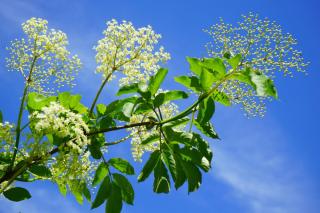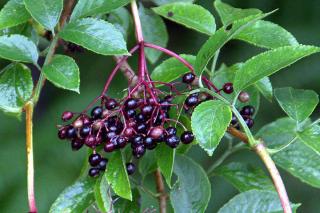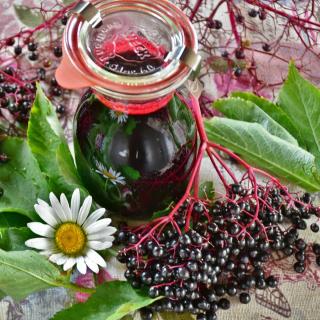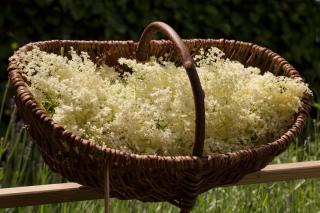

Elder is a beautiful flowered shrub noted for its edible fruits that are a boon to our bird friends.
Basic Black Elder facts
Name – Sambucus nigra
Family – Adoxaceae
Type – shrub
Height – 6 to 10 feet (2 to 3 meters)
Exposure – full sun or part sun
Soil – any
Foliage – deciduous
Flowering – June to July
Elder is planted indifferently in fall or spring.
 Planting it in fall makes it easier for the plant to resume growth in spring. If you must plant in spring, provide for regular watering at the beginning to ensure that the roots dive deep into the ground.
Planting it in fall makes it easier for the plant to resume growth in spring. If you must plant in spring, provide for regular watering at the beginning to ensure that the roots dive deep into the ground.
It loves sun and any type of soil: chalky, moist, dry…
Elder is a tree that calls for almost no care. It is really easygoing and it stands strong in the face of most diseases.
To deepen the hue of your elder, cut back the branches by about ⅓ at the beginning of spring.
 It loves rich soil but suits itself nonetheless in ordinary soil, provided the ground isn’t too compact. When planted in fall, in the sun or part sun, within 3 years it will have grown quickly to reach nearly ten feet (three meters). Flowers appear in the second year.
It loves rich soil but suits itself nonetheless in ordinary soil, provided the ground isn’t too compact. When planted in fall, in the sun or part sun, within 3 years it will have grown quickly to reach nearly ten feet (three meters). Flowers appear in the second year.
There are different wild and horticultural varieties. Domesticated horticultural varieties make for smaller, more controlled trees. The flowers range from pink to cream, and its leaves can be dark purple (‘Black Beauty’, ‘Black lace’) or mottled (‘Albovariegata’).
Care is redundant: simply remove one third of the old wood at the beginning of spring and mulch in summer.
Elder furnishes light leafage, a discrete colorful blooming and fruits that are almost black and are a magnet for birds.
They usually grow alongside fields to form wild hedges, but it is also very easy to grow this shrub in your own premises.
 With its white fragrant umbels in spring, its berries in fall and its purple or mottled leaves, the “fairy tree” as it is know in Brittany definitely deserves a spot in our gardens. It can rise at the back of a shrub bed, close a wild countryside hedge, or even grow into a tree – if you remove lower branches – for a small garden.
With its white fragrant umbels in spring, its berries in fall and its purple or mottled leaves, the “fairy tree” as it is know in Brittany definitely deserves a spot in our gardens. It can rise at the back of a shrub bed, close a wild countryside hedge, or even grow into a tree – if you remove lower branches – for a small garden.
Fruits and flowers can both be consumed. The flowers are even brewed to wine in Scandinavian countries. However, best avoid eating the berries raw because they’re slightly poisonous and might lead to vomiting.
From elder emanates an appealing vanilla-like fragrance.
The berries when cooked are perfectly edible. They make for delicious elderberry jam, lemonade and syrup.
 Each part of the elder shrub can be used either in the garden or in the kitchen. Its flowers can be eaten as fritter and are part of syrup, liquor, lemonade, wine… When dried, they make for soothing infusions. The berries have elevated vitamin C content. They can be eaten in jelly, compote (together with apples) and jams.
Each part of the elder shrub can be used either in the garden or in the kitchen. Its flowers can be eaten as fritter and are part of syrup, liquor, lemonade, wine… When dried, they make for soothing infusions. The berries have elevated vitamin C content. They can be eaten in jelly, compote (together with apples) and jams.
Elder fruits are edible only for one variety, black elder (Sambucus nigra). Berries from other varieties aren’t edible.
It is important to cook the berries to eliminate any risk of poisoning.
If in doubt, look it up… or you’ll experience gastric disorders.
In the garden, elder is like a vibrant bus station. In spring, its flowers attract butterflies, bees and other useful insects. In summer, birds drop by for berries.
The leaves break down really fast, which makes them good compost activators. They can also be used in decoctions to fight off flea beetles, aphids and cabbage moths. Macerate 35 oz (1 kg) of leaves in 10 quarts (10 liters) water for a day, boil for 30 minutes, filter and spray on your plantations. If you let it macerate for 10 days without boiling, you’ll have prepared a repellent against moles, voles and field mice.
Elder fermented tea is an excellent option to treat plants organically against such parasites as aphids or caterpillars.
The elder fermented tea recipe is easy to follow: 35 oz (1 kg) leaves in 10 quarts (10 liters), ferment for 3 to 6 days and filter before spraying.
Read also on the topic of shrubs:
Elder grows very fast, which makes it a great shrub to hide away from prying eyes.